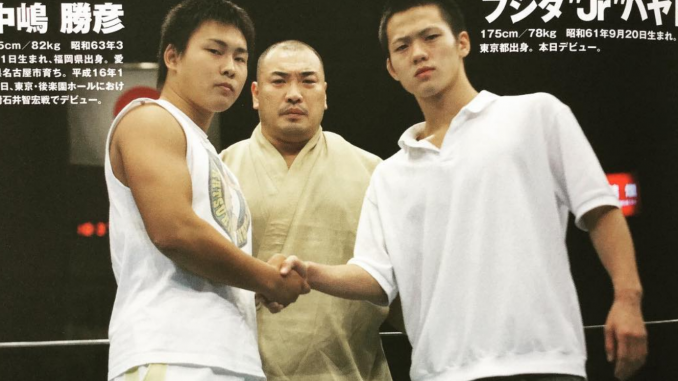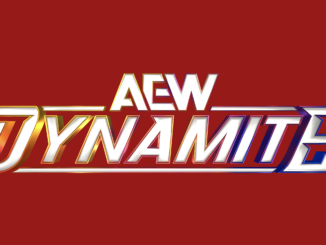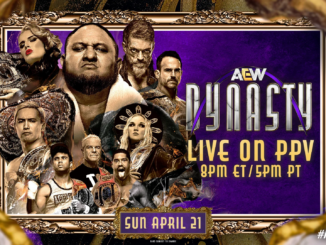
SPOTLIGHTED PODCAST ALERT (YOUR ARTICLE BEGINS A FEW INCHES DOWN)...
“Walk blindly to the light and reach out for his hand”
Based primarily in the Tohoku region of northern Japan, the Michinoku Pro promotion always attempted to put their best foot forward when they came south to the nation’s capital of Tokyo. This was the case on Feb. 4, 1994 when they made their first appearance at Korakuen Hall and the new young talent at the forefront of the promotion tore the house down. It was similarly the case at the famous “These Days” event in Sumo Hall in October 1996 which became a must have for every tape collector in the west.
On Dec. 3, 2004, the M-Pro crew returned to Korakuen for their first show there in nearly three years. Many of the stars of the past had moved on to pastures new, but even with that in mind, the chosen main event for the evening was surprising to say the least. In the show’s feature bout they were trusting an outsider, 16 year old Katsuhiko Nakajima (barely a year into his career), with the task alongside another young man at 18 years of age. This opponent had never even competed in a professional wrestling match. He was about 5ft7 and maybe 140 lbs soaking wet. But he was special.
He was special and it was obvious.
- Magnetism
- Aura
- Charisma
- Different
These are words I think of when I think of Fujita “Jr” Hayato. It’s hard to ignore when you see him.
Jinsei Shinzaki didn’t ignore it when he first laid his eyes on Hayato. Who would understand those four words better than the former “Hakushi”, one of the most magnetic and unique wrestlers of all time. His gimmick and look is so identifiable, clad in all white, stoic at all times. “Jinsei” meaning “life” was the perfect name for a character a stark contrast to the likes of The Great Muta and The Undertaker who were two of his most memorable opponents in Japan (it’s somewhat forgotten that ‘Taker had a much hyped appearance for M-Pro in 1997). The Muta match at a 1996 New Japan Tokyo Dome show was presented almost as Light vs. Darkness, Heaven vs. Hell and it’s one of the coolest spectacle matches in NJPW history.
Whilst the character would still appear in the ring during the 2000s, Shinzaki’s role as M-Pro president was a larger part of his career and it has continued to this day. One of his most important tasks for this small promotion was recruitment, and he was in attendance at a national Greco Roman Wrestling tournament where a young Hayato caught his eye. The relationship blossomed and Fujita’s pro wrestling training would begin alongside MMA training under K-1 Legend Kid Yamamoto. The lucharesu style taught in the M-Pro dojo and the shoot training in Yamamoto’s “Krazy Bee” camp were about as different as you can imagine but it was all part of the recipe that made a truly unique wrestler.
Another major part of that recipe was toughness, and it’s easy to see where “Jr” gets that from. Both of his parents are people with disabilities, his father having overcome cerebral palsy to compete in amateur wrestling himself and also for the Doglegs promotion – a pro wrestling company launched as a volunteer group for people with disabilities in 1991. His father taught him amateur wrestling at the age of 8 and he went on to great success at different age levels.
The combination of his amateur success, his training at Krazy Bee, the endearing story of his parents and the association with Shinzaki who was very much positioned as his mentor, made Hayato’s debut a draw. The anticipation and curiosity surrounding him was the reason why he was in this main event with no professional experience.
His opponent, as noted, was Katsuhiko Nakajima then only 16 years old with a unique story himself as he began his pro wrestling journey. Nakajima grew up without a father, and was raised by his mother until 2002 when he was signed as a 14 year old to Riki Choshu’s new World Japan promotion. Young Nakajima moved into the WJ dojo where the high level karate skills he had honed from a young age gave him the toughness and athleticism he needed to thrive. Choshu felt he had a diamond in Nakajima but rather than gradually shaping his future star, he strangely felt the need to enter him into MMA competition for “X-1” in September 2003. This was the debut of a promotion which only ran one other show (six years later) and at the time Choshu and WJ were clearly involved in. It was a vehicle for another Choshu disciple, former IWGP Heavyweight Champion Kensuke Sasaki, to gain MMA credibility, and a cynic might say that Christian Wellisch and Jason Leigh, the respective opponents of Sasaki and Nakajima, may not have been motivated to get their hands raised on this night.
Whether these fights were rigged or not, having watched Nakajima’s performance, I can tell you that the 15 year old absolutely did not think this was a work. He fought his opponent (who looked to be double his age) like his life depended on it and even continued to attack like a wild animal after the 1:25 1st Round TKO. Nakajima needed to be pulled off and it really wasn’t a pleasant scene. This was a child being put in a situation that he really shouldn’t have been in, but it’s hard to say that the experience wasn’t an ingredient in making the hard nosed, tough wrestler that Nakajima has become.
He made his pro wrestling debut again Tomohiro Ishii in January 2004 and was very much in Choshu’s plans to be one of WJ’s stars. Unfortunately for those plans, Nakajima would have his last WJ match just two months later. Choshu and Kensuke had a major falling out and Kensuke left the promotion in April. The promotion would only survive until June. Nakajima sided with Sasaki in the split and he was adopted by Kensuke and his wife Akira Hokuto, the famous All Japan Women star. It has never really been clear if this was an official adoption but they absolutely branded it as such and he was portrayed as a part of the “Kensuke Family”. Nakajima would spend the rest of 2004, travelling alongside Japan’s most in demand freelancer and was able to wrestle all kinds of legends such as Gran Hamada, Masahiro Chono, Ultimo Dragon, and Jushin Thunder Liger (at the Tokyo Dome no less). He even competed in that year’s Best Of The Super Juniors for New Japan, all while 16 years old.
Nakajima entered the ring at Korakuen all business. There were no frills to the entrance. He walked straight to his corner with a steely focus and buried his head in the top turnbuckle. It was a different story for our debutant.
As the opening notes of T.O.K.’s “I Believe” sounded in the famous hall, we see Hayato standing at the entrance, back turned surrounded by cornermen – most notably Shinzaki. Clad in a gold jumpsuit matching his bleached blonde hair, he turned and marched confidently to the ring. He swayed to the beat of his chosen song like the coolest dude on earth, not even breaking stride as he clutched bouquets of flowers in each hand from fans. He stopped at the apron to remove his entrance attire, and bring his hands together in prayer – a moment of peacefulness before letting out an excited yell to the crowd as he burst into the ring and circled in front of his opponent.
The ring announcer introduces both competitors as we see a shot of Kensuke Sasaki sitting in the front row, watching on. To him, there was no need for Nakajima to have an entourage or even just his mentor in his corner. He felt this was just another match for his boy, just another experience. A stark contrast to the other side of the ring where Shinzaki & Co were gathered for a major event in their life. This is reflected when the bell rings. Nakajima can’t even get into a fighting stance and Hayato has already bolted across the ring like the speed of light and in his very first profession wrestling manoeuvre hits, honest to God, maybe the best double leg takedown I’ve ever seen.
After refusing to release an armbar when Nakajima got to the ropes, legendary referee Ted Tanabe had to physically pull Hayato off his downed opponent. It was reminiscent of the scenes from Nakajima’s foray into MMA but with the shoe firmly on the other foot. Hayato was FIRED UP and he let the crowd know it. They responded to him instantly but so did Nakajima. The youngster, back on his feet, struck swiftly with a vicious pair of kicks – to the leg and chest.
As things start to settle down, we get a few minutes of good solid grappling as Nakajima begins to take control with his size and experience proving difficult for Jr. As he sits down deep in a Boston Crab (a move traditionally used in Japan to “break” rookies”, we see Hayato display one of his best skills. His selling and ability to garner sympathy, even as a “Bad Boy”, were obvious from the get go and the crowd urged him on. We get the fantastic shot of him in agony reaching for the bottom rope and essentially the light that stood behind it – his light, Jinsei Shinzaki.
Hayato’s toughness comes to the fore as he eats some heavy Nakajima kicks in order to seize on an opening and hit a beautiful Dragon Screw. It’s clear technique is on point. A brief flurry of forearms however is snuffed out when Kensuke’s kid obliterates him with a spin kick that looked every bit as devastating as Sasaki’s most famous lariats. Hayato survives Tanabe’s standing count and quickly after making it to his feet hits a surprise jumping guillotine, catching Nakajima off guard. The move that would come to be known as K.I.D in tribute to his Krazy Bee leader looked like it could end the contest, so much so that Shinzaki leapt to the apron – living and dying with his protégé. Nakajima dramatically gets a foot to the rope and the window of hope closes.
Seven minutes in and it seemed like young Hayato had exhausted his energy for his first night as a professional wrestler. Nakajima was able to seize control again quickly and use his brutal kicks to set up another Boston Crab. This time there was no light at the end of the tunnel for Hayato and he had to tap out at 7:31. Nakajima gets his hand raised but Hayato made one heck of a first impression, not just on the fans but also on his opponent who respectfully meets him in an embrace and bows before leaving the ring to Michinoku Pro’s new great hope.
Nakajima’s music fades out and we’re left with a moment of quite reflection for Jr as he stands alone in the middle of Korakuen Hall. The crowd begins to applaud and he gets a tremendous response before making his way to his parents in the crowd. His mother is clearly very emotional at this moment, and you can see Hayato’s eyes welling up before he bows to them. His father bows in response and Hayato picks him up for a hug and it’s a tear-jerker folks. He continues his journey around ringside and eventually approaches the wall of a man that is Kensuke Sasaki. Clearly knowing that this kid is something special, Sasaki gives him a firm pat on the back and some words of advice into his ear.
There’s one final person for Hayato to approach. The one that will wait for him always. Jinsei Shinzaki stood in the aisle, towel at the ready, and draped it over the shoulders of his defeated young warrior. With his arm around him, he walked him backstage. That was December 2004 and in sixteen and a half years, he has not taken that arm from around Hayato’s shoulders.
In the years that followed, the journeys of Katsuhiko Nakajima and Fujita “Jr.” Hayato would take them different places. Nakajima would follow Sasaki and build the “Kensuke Office” brand in promotions like All Japan and Pro Wrestling NOAH, along with their own shows where he got to face some of the best competition in the country. He would win the junior championship in both AJPW and NOAH and would engage in one of the best rivalries in modern Japanese wrestling history against KENTA.
Hayato would spend over a year in Mexico training in the Toryumon system and living in their dojo over there. He was defeated by a very young Kazuchika Okada in the semi finals of the 2005 Young Dragons Cup in Mexico City, and would even cross paths with Chris Hero and Claudio Castagnoli in 2006. Upon returning to Japan he went to work in a big way, wrestling a busy schedule with M-Pro and taking several outside independent bookings. For instance, in the short lived “UWAI STATION” he went one on one with Bryan Danielson of all people, and on M-Pro’s big 2006 year-end show at Korakuen, he faced Katsuyori Shibata in a match where he took quite the beating. Two years later, and again in December, M-Pro’s vision for him was realised and he won their top prize – the Tohoku Junior Heavyweight Championship, defeating Yoshitsune in an amazing match at Korakuen.
As they made their names as two of the top young wrestlers in Japan, Nakajima and Hayato crossed paths either as opponents or partners fifteen more times between 2008 and 2012. Three of those bouts were singles matches and Nakajima maintained his dominance in the rivalry until their final meeting. Eight years on from that night in 2004 and once again on the show that had become synonymous with Hayato, Michinoku Pro’s December year ender at Korakuen, the two warriors battled with the Tohoku championship on the line.
Entrusted with carrying forward the legacy of Michinoku Pro, Fujita “Jr.” Hayato needed to protect their top prize from falling into an outsider’s hands. To do so, he needed to overcome the rival two years his junior who always had his number. December 13th 2012 was Hayato’s chance to close a chapter of his life that started on December 3rd 2004.
The match may not have had the special feeling of their first encounter, but it was quite clearly a better, more mature performance from both – as would be expected. After 20 hard fought minutes, Hayato reversed a German Suplex attempt with K.I.D. and put Nakajima to sleep. Whilst he didn’t need cornering from his mentor Shinzaki anymore, the pair would take centre stage after the match as the company president presented it’s champion with the title that he had defended. Hayato would place it across his back and he closed out the show with a rallying promo for the fans. 8 years after ending the night draped in a towel with tears in his eyes, he ends the night draped in gold.
Whilst the story of Hayato and Nakajima had ended, the story of Hayato and Jinsei would continue and take a sad turn. Hayato probably could have moved on to a bigger promotion on multiple occasions during his career. He was very much on New Japan’s radar and competed in the Best Of The Super Juniors in 2010 and 2011. But he stayed loyal to Michinoku Pro, and he stayed loyal to Shinaki. The former Hakushi was his light, and he walked blindly towards it – just as the lyrics of “I Believe” suggest. He never walked away from it. And when he needed it more than ever, it was there for him.
In 2018, Norifumi “Kid” Yamamoto died of stomach cancer, aged just 41. Just weeks after the death of his hero, Fujita “Jr.” Hayato was diagnosed with a cancerous tumour on his spine. It was a crushing period for him. He was faced with the reality that his wrestling career would be over, and that his life was very much at risk. However Hayato has fought back against this situation with the tenacity and defiance he showed at 18 years of age in his debut, and like on that night, he’s done it with Jinsei Shinzaki in his corner supporting him all the way.
In May of last year, Shinzaki announced that Hayato had made it through a five hour procedure with the doctors removing 70% of a malignant tumor from the nerves of the lumbar spine region. However removal of the remaining 30% would have required all of his nerves in that area to be killed and as such leave him paralysed from the waist down. Hayato is determined to continue as a professional wrestler and opted to move forward with the remaining part of the tumour still on his spine. However, if at any point the tumour still shows to be malignant, then there would be little choice left.
There hasn’t been a ton of news on the situation coming out of Japan in recent months. Hayato is active on social media, and appears to be living a nice life based on photos. Shinzaki and others ran a benefit show for him in November at Shinjuku FACE in Tokyo and Hayato announced that for the M-Pro year end show of 2019 he would compete in a special one off return match to open the show. The match saw him face his friend Kengo in a losing effort which went just over shy of 13 minutes. Hayato wrestled in a t-shirt but looked to be doing ok all things considered. He wrestled hard and put in a gutsy performance. It was clearly a really emotional deal for him. Perhaps he realised it would be his last match ever as a pro wrestler, or maybe it just reminded him of what he still wants to do so much but he just can’t yet.
Whatever happens it’s clear that Fujita “Jr.” Hayato will fight until the bitter end. He believes, and he will always have his light.




Leave a Reply
You must be logged in to post a comment.